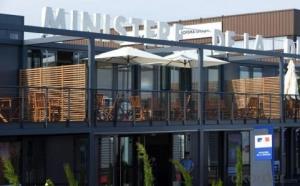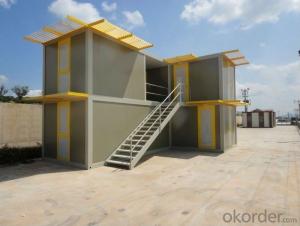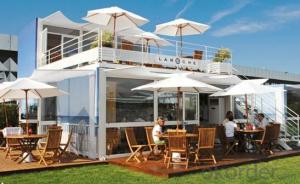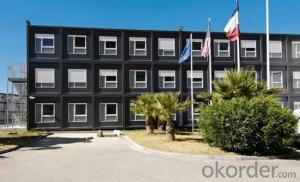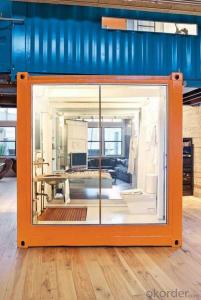High quality decorated container house for Dormitory
- Loading Port:
- China Main Port
- Payment Terms:
- TT OR LC
- Min Order Qty:
- -
- Supply Capability:
- -
OKorder Service Pledge
Quality Product, Order Online Tracking, Timely Delivery
OKorder Financial Service
Credit Rating, Credit Services, Credit Purchasing
You Might Also Like
High quality decorated container house for Dormitory
Specification

Production Process
Frame

Floor


roof



Window

Door

Layout


Application


we also have prefab villa house

- Q: Are container houses suitable for communal or co-housing communities?
- Container houses can be a suitable option for communal or co-housing communities for several reasons. Firstly, container houses are highly versatile and can be easily customized to meet the specific needs and preferences of the community members. They can be arranged in different configurations to create shared spaces such as common areas, communal kitchens, and recreational areas. Additionally, container houses are relatively affordable compared to traditional housing options, making them more accessible for individuals who are looking to join a communal or co-housing community. This affordability can help create a more inclusive and diverse community, as it lowers the barrier to entry for individuals with limited financial resources. Container houses also offer sustainability benefits, which align well with the values of many communal or co-housing communities. These homes can be built using recycled materials, reducing the environmental impact of construction. Furthermore, container houses are energy-efficient and can be equipped with renewable energy sources such as solar panels, promoting a more sustainable and eco-friendly lifestyle for the community members. Furthermore, container houses can be easily transported and relocated, allowing communal or co-housing communities to adapt and grow over time. This flexibility enables the community to respond to changing needs and demographics without the need for significant structural modifications or expensive construction processes. However, it is important to note that container houses may have some limitations for communal or co-housing communities. The smaller size of container homes may result in limited personal space for individuals, and privacy could be a concern. Additionally, container houses may require additional insulation and ventilation systems to ensure adequate comfort and livability, especially in extreme weather conditions. Overall, container houses can be a suitable option for communal or co-housing communities due to their versatility, affordability, sustainability, and flexibility. However, careful planning and consideration of the specific needs and preferences of the community members are crucial to ensure that container houses can effectively accommodate communal living arrangements.
- Q: Can container houses be designed with a wheelchair-accessible layout?
- Yes, container houses can be designed with a wheelchair-accessible layout. With proper planning and design, container houses can be modified to include features such as wider doorways, ramps, accessible bathrooms, and open floor plans to accommodate wheelchair users. Additionally, adaptable furniture and storage solutions can be incorporated to enhance accessibility and maneuverability within the space.
- Q: Can container houses withstand natural disasters?
- Yes, container houses can withstand natural disasters. The use of durable steel containers as the primary building material makes them highly resistant to extreme weather conditions such as hurricanes, earthquakes, and wildfires. Additionally, these houses can be reinforced and designed with proper structural engineering to ensure their stability and safety during natural disasters.
- Q: Can container houses be designed to have an open-concept layout?
- Yes, container houses can be designed to have an open-concept layout. The modular nature of containers allows for flexibility in design, allowing for walls to be removed or repositioned to create open and spacious living areas. Additionally, the use of large windows and strategic placement of furniture can further enhance the open feel of the space.
- Q: What are the advantages of the container house?
- Third, the sealing performance is good, strict manufacturing process so that this activity room has a good watertight;
- Q: Can container houses be designed with a built-in storage system?
- Certainly, it is entirely possible to design container houses with an integrated storage system. Indeed, one of the benefits of utilizing shipping containers for housing lies in their inherent storage capacity. The containers' large and robust structure permits the implementation of imaginative and efficient storage solutions. Designers and architects have the ability to include a variety of storage options within container homes, such as inbuilt shelves, cabinets, and closets. These storage systems can be tailored to suit the specific requirements and preferences of the homeowner. By employing wall-mounted storage units or constructing built-in loft spaces, the vertical space within the containers can be maximized. Furthermore, container houses can also boast innovative storage solutions that cleverly utilize the unique characteristics of the containers. For instance, certain designs incorporate sliding panels or concealed compartments within the walls or floors of the containers, providing additional storage space without compromising the aesthetic appeal of the home. All in all, container houses offer immense potential for integrating a built-in storage system, enabling homeowners to optimize the available space and maintain a neat and organized living environment.
- Q: Are container houses fire-resistant?
- Fire resistance can be achieved in container houses, but it relies on the materials chosen for construction. The steel structure of shipping containers inherently offers some level of fire resistance since steel is not combustible. However, the overall fire resistance of the container house is determined by the finishes applied both inside and outside, including insulation, cladding, and roofing. To enhance fire resistance, fire-resistant materials like mineral wool insulation can be used during construction. Mineral wool has a high resistance to fire, making it an ideal choice. Additionally, fire-resistant cladding materials such as cement fiberboard or metal panels can be utilized to further safeguard the container house against fire hazards. Fire-resistant roofing materials like metal or concrete can also be employed to minimize the risk of fire spreading through the roof. It is important to emphasize that adherence to building codes and regulations is crucial when constructing fire-resistant container houses. This ensures that proper fire safety measures are implemented, such as the installation of fire alarms, smoke detectors, fire extinguishers, and adequate escape routes. In conclusion, by using appropriate materials and following fire safety standards, container houses can indeed be made fire-resistant, thus providing a safer living environment for their occupants.
- Q: Are container houses suitable for year-round living?
- Yes, container houses are suitable for year-round living. They are designed to be durable, weather-resistant, and energy-efficient, making them suitable for various climates. With proper insulation, heating, and cooling systems, container houses can provide comfortable living conditions throughout the year.
- Q: Can container houses be built with a rustic charm?
- Yes, container houses can definitely be built with a rustic charm. While containers are typically associated with a modern and industrial aesthetic, with the right design and materials, they can also be transformed into cozy and rustic homes. To achieve a rustic charm, there are several design elements that can be incorporated into container houses. One approach is to use natural building materials such as wood or stone for the exterior cladding. This can give the house a warm and traditional look, reminiscent of a cabin or a farmhouse. Another way to add rustic charm to a container house is through the interior design. The use of reclaimed or salvaged wood for flooring, walls, and furniture can create a cozy and rustic atmosphere. Exposed beams, vintage fixtures, and handcrafted details can further enhance the rustic appeal. Additionally, incorporating nature into the design can contribute to the rustic charm of a container house. Large windows or glass doors can provide ample natural light and beautiful views of the surrounding landscape. Adding a porch or a deck can also create a welcoming outdoor space that complements the rustic aesthetic. In summary, while container houses are often associated with a modern and industrial style, they can absolutely be built with a rustic charm. With the right design choices, materials, and attention to detail, container houses can have a warm and inviting character that reflects the charm of a traditional rustic home.
- Q: Are container houses suitable for temporary housing solutions?
- Yes, container houses are suitable for temporary housing solutions. They are cost-effective, easily transportable, and can be quickly assembled or disassembled. Container houses also provide necessary amenities and can be customized to meet specific needs, making them a practical choice for temporary housing in various situations such as disaster relief or construction sites.
Send your message to us
High quality decorated container house for Dormitory
- Loading Port:
- China Main Port
- Payment Terms:
- TT OR LC
- Min Order Qty:
- -
- Supply Capability:
- -
OKorder Service Pledge
Quality Product, Order Online Tracking, Timely Delivery
OKorder Financial Service
Credit Rating, Credit Services, Credit Purchasing
Similar products
Hot products
Hot Searches
Related keywords











